Menu

Farmers save over $800,000 each year on energy thanks to green projects. This shows the big impact of renewable energy in farming. It cuts costs and lessens their impact on the environment.
The farming sector plays a big role in climate change. The globe will have about 10 billion people by 2050. To meet this challenge, farms are turning to renewable energy. They now use creative methods such as agrivoltaic farming. This means allowing crops to grow under the shade of solar panels, saving water and space.
Another example is using the Earth’s heat for farming purposes through geothermal systems. This method alone reduces the need for other harmful energy sources. Plus, we see greenhouses using technology powered by biogas to keep energy costs down. Such green solutions are very important and lead the way for a cleaner, more productive future.
The Massachusetts Farm Energy Program (MFEP) is a great example. It highlights the many ways renewable energy can benefit farming. The program shows how systems like anaerobic digesters, advanced climate control in greenhouses, and efficient fridges help. These projects are vital as farming changes to keep up with food needs and fight climate change.
Renewable energy is vital for farming, helping to create a sustainable future. It focuses on using clean energy solutions to fight climate change. The agricultural sector needs to adopt sustainable agricultural methods to reduce its impact on the planet.
Many farms still rely on old-fashioned energy, which harms the environment. Now, it is crucial to include renewable energy in farming. The United Nations states that it’s urgent for agriculture to become sustainable. By using renewable energy, farmers can save money and help the environment.
Renewable energy has many advantages for agriculture. Solar power, for example, can cut electricity costs for farmers. Meanwhile, wind energy can also offer extra money, especially in windy areas.
Biofuels provide a green option against fossil fuels. They are made from crops grown on the farm. Then we have geothermal energy, which can save money in the long run and doesn’t need to be paid for after 5-10 years.
This list also includes hydropower and photovoltaics. They are becoming more affordable and efficient. This makes them a good fit for farming.
There’s a lot of help available for farmers to switch to renewable energy. The REAP can cover up to half of the costs. With the ITC, solar costs can be slashed by 30%. State-level programs also give benefits for eco-friendly farming projects.
Switching to renewable energy is smart for both the planet and the pocket. It supports global efforts against climate change. And it offers a sustainable future for farming.
| Renewable Energy Type | Benefits | Cost Considerations |
|---|---|---|
| Solar Power | Reduces electricity bills | Investment Tax Credit (ITC) reduces costs by 30% |
| Wind Energy | Generates electricity and additional income | $13,000 to $40,000 for residential systems |
| Biofuels | Environmentally friendly fuel alternative | Can provide up to $20 billion in new income |
| Geothermal | Long-term cost reduction, free fuel | Payback time of 5-10 years |
| Hydropower | Long lifespan of 20-25 years | Significant initial investment but durable |
Farming now often uses renewable energy to be more sustainable and efficient. Let’s look at the main types of renewable energy that farmers use.
Solar energy is well-liked by farmers for being flexible and effective. Using solar panels above crops, called agrivoltaic farming, has made farm water use over 300% more effective. Solar panel costs for homes vary between $15,000 and $40,000. The panels themselves start at $4,000 to $16,000. Solar water heaters have been found to lower heating costs by as much as 85% every year. Dairy farms save money with solar thermal systems, reducing water heating bills by a lot.
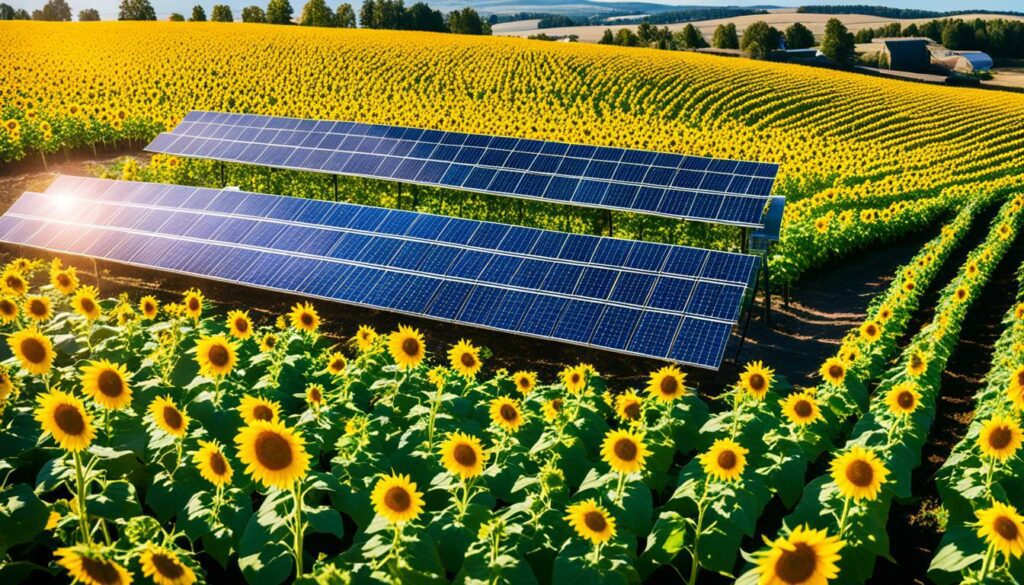
For farms in windy areas with speeds over 10 mph on average, wind power is a good option. Installing wind turbines might cost $13,000 to $40,000. They can bring in good money, with companies paying $2,000 to $5,000 per turbine each year. Wind power does more than provide a clean, never-ending energy source. It could also lead to 80,000 new jobs and $1.2 billion in income for farmers and landowners, as reported by the U.S. Department of Energy.
Geothermal energy works well for keeping greenhouses at the right temperature. It pays off in 5-10 years thanks to the low cost of the energy source. A flower farm in the U.S., for instance, saw their heating bills drop from $1,000 to $100 monthly after they started using geothermal systems. The use of small hydroelectric systems also shows how useful geothermal energy can be in farming over a long period.
Making biogas from organic waste like animal manure provides a both cheap and green energy source. It supports making biogas and biopower, usually by burning gas from special tanks. If the U.S. increased its use of biomass for energy threefold, it could bring in up to $20 billion more for farmers and local communities. Growing specific oilseed crops, such as sunflowers and canola, can help make farms more energy independent.
| Renewable Energy Type | Key Benefits |
|---|---|
| Solar Energy | Reduces water heating costs by up to 85% annually; increases water efficiency by 300%. |
| Wind Energy | Generates income for farmers; produces jobs; harnesses strong seasonal winds. |
| Geothermal Energy | Regulates greenhouse temperatures; reduces heating costs; has a lifespan of 20-25 years for hydroelectric systems. |
| Biogas | Provides economical and sustainable heating; can generate up to $20 billion in new income. |
Using these renewable energies can cut farming costs and help the environment. With the need for food growing, these eco-friendly options are more important than ever.
Choosing sustainable agriculture is key to keeping a farm healthy. It makes the soil better, saves water, and uses farming methods that care for the environment.
Crop rotation is a big part of keeping farming sustainable. It helps the soil stay fertile and stops pests and diseases from becoming a big problem. When farmers grow different crops in the same area, it confuses pests and cuts down on needing harmful chemicals to kill them.
Using crops with different needs also helps keep the soil full of all the nutrients it needs. This keeps the soil healthy, meaning plants grow better without exhausting the land.
Minding the soil also means protecting it and keeping it full of life. Cover crops and cutting down on how much we till the soil can do this. Cover crops stop the soil from washing away, help water sink in better, and give the soil more good stuff. Not digging up the soil too much keeps its natural structure and the tiny life forms in it alive.
These steps not only keep the soil in good shape but help to fight climate change too. They trap carbon, which is good for the planet.
Looking after water is vital as we face more water problems worldwide. Smart ways of watering, like drip systems, can use a lot less water than usual ways. Drip systems put water right where plants need it, stopping it from just going into the air or off the ground.
Another good way to save water is to catch rain for the farm. It helps use less underground and surface water. Also, planting crops that don’t need as much water is smart. They save water and can still grow even when water is scarce.
Doing these things helps make farming long-lasting. By farming smarter, we make sure the land stays healthy, uses less water, and is good for producing food for everyone.
Switching to renewable energy helps farmers in many ways. It is good for the planet and their wallets. This change brings real financial benefits alongside reduced harm to the environment.
Farmers can earn more by renting out land for energy projects. They can also make money by selling extra energy. Take solar power for instance. It gives farmers steady money from leases.
Wind power is great for areas with lots of wind. Farmers there can use or sell extra electricity. This means a reliable source of income when the wind blows hard.
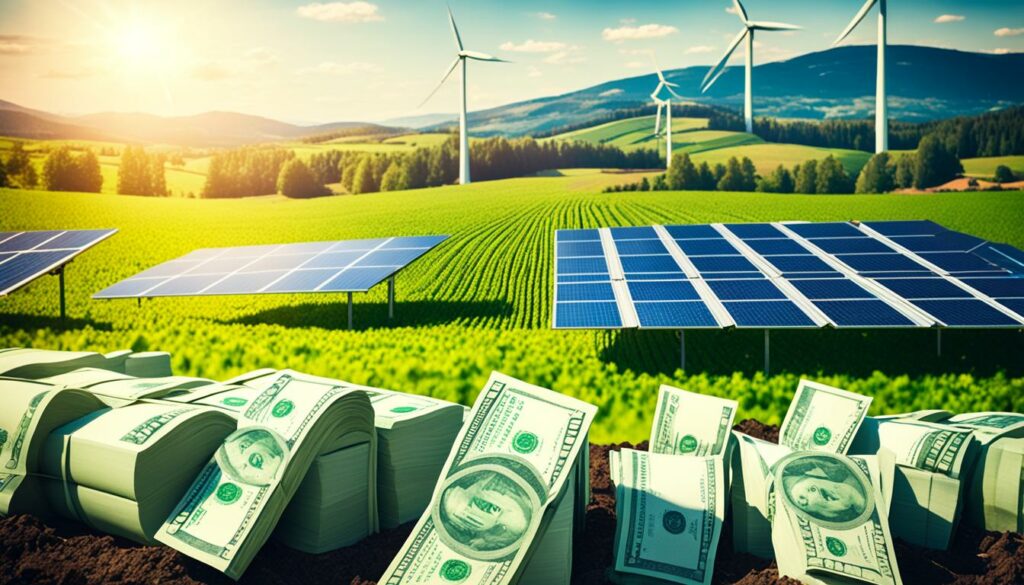
Biofuels, from crops like corn and soy, offer more income. They also give us a cleaner fuel option than oil. Big farms can make a lot of clean power with solar or wind. This power runs their farm equipment and makes extra money selling power back.
Using solar power can cut a farm’s electric bill by a lot. It’s cheaper than putting up new power lines. Wind and geothermal power also help, making farms less dependent on costly energy.
Geothermal energy lowers the cost of heating greenhouses. There are also grants and tax breaks for renewable projects. These help farmers save money and be more eco-friendly.
Wind power, for example, could bring $1.2 billion to farms and rural areas. Using more biomass energy could mean up to $20 billion in new money. This shows how renewable energy can make farms more financially and food secure.
“Investing in renewable energy sources such as solar panels, wind turbines, and biofuels can decrease reliance on expensive conventional energy sources and reduce operational costs for farmers.”
Clearly, switching to renewable energy brings extra income and saves money for farmers. It’s a win for both their bank accounts and the planet.
By looking at real-world cases, we see how renewable energy is changing farming for the better. Specifically, we explore how solar panels and geothermal energy help. These examples show how new tech makes farms more eco-friendly and efficient.
In Australia, putting solar panels in fields where sheep graze has worked well. The panels produce power for the farm and boost wool quality. This approach, seen in many renewable energy studies, also benefits nature and the sheep’s health.
Using the Earth’s heat in greenhouses offers big savings. A flower grower in the U.S. cut their heating bill from $1,000 to $100 monthly with geothermal. This change was not just good for the business but also for the planet. It proves mixing energy sources saves money and helps the environment.
These cases prove renewable tech works well in farming. They are good models for farmers to follow, showing the clear advantages and pushing for more use of these systems.
Using renewable energy on farms comes with big challenges. The main ones are money problems and technical difficulties. But, knowing these challenges is key to making the most of renewable energy.
Bringing renewable energy to farms is hard because of the high costs. Things like solar panels and wind turbines cost a lot at first. It’s tough for farmers to find this money.
Yet, there are ways to help farmers with these money issues. Government schemes, like the Investment Tax Credit, can lower costs by 30%. Also, programs like the Rural Energy for America Program (REAP) give farmers money to cover up to 75% of costs. These help a lot, making it easier for farmers to go green.
Switching to renewable energy can be technically challenging on farms. Mixing new energy tech with old farm structures needs know-how. Solar, for example, needs changes and smart systems to work best.
New farming tech, like sensors and AI, are being used to solve these issues. They make renewable energy systems more effective and easier to use. Before picking a renewable tech, studying the farm’s energy needs is vital. This makes sure the system chosen fits well with the farm’s energy use.
The following table provides a brief overview of the financial barriers and technical solutions to adopting renewable energy on farms:
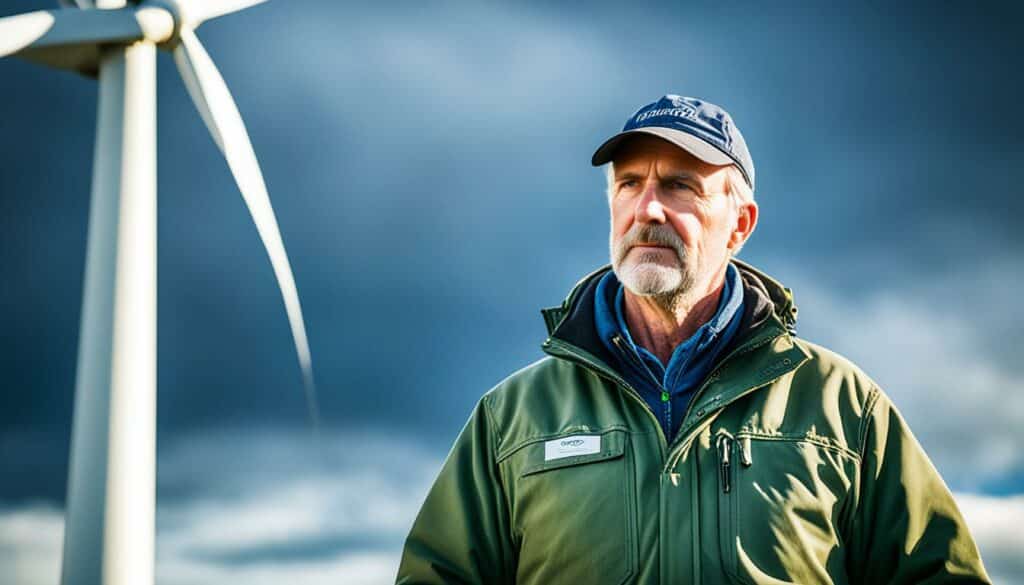
| Challenge | Financial Barriers | Technical Challenges |
|---|---|---|
| Barriers | High initial investment, limited capital | Integration with existing infrastructure, technical expertise |
| Solutions | Government grants, tax incentives, public-private partnerships | Advanced technologies (sensors, IoT, AI), thorough energy requirement analysis |
To address renewable energy challenges, it’s important to use new financing and tech. Getting help from the government is also crucial. This combined effort will help farmers beat money and technical problems. It leads to a future where farms are more sustainable and independent in energy.
Renewable energy is key in fighting climate change in farming. Around 30% of world’s energy use comes from agriculture. This makes using sustainable energy very important. Green farming, using solar, wind, geothermal, and biomass energy, can cut down on harmful gas leaks, helping our planet.
By turning to renewable energy, farming can lessen its use of fossil fuels. This means less harm done to our planet. For instance, using solar power to heat greenhouses and grow crops shows how we can change for the better.
| Type | Application | Benefits |
|---|---|---|
| Solar Energy | Agrivoltaic systems | Lower carbon footprint, increased water efficiency, dual land use |
| Wind Energy | Field installations | Continuous power supply, potential for income through power sales |
| Geothermal Energy | Greenhouse heating | Efficient temperature regulation, reduced heating costs |
| Biomass and Bioenergy | Organic waste conversion | Reduced greenhouse gas emissions, support for resource efficiency |
The big issue is lack of money for green energy research in farming. Many research funds go to other areas, not agriculture. This shortage of funds slows down the study of important green technologies.
“I believe that collaboration across disciplines such as agriculture, energy systems, engineering, and environmental science is vital to overcoming the integration challenges,” notes a recent study published in Sustain Energy Technol Assess.
Turning to sustainable farming helps reduce damage to the environment. It also prepares us better for bad climate change effects. Stories of solar power in apple farming and agrivoltaic systems show we’re making real progress in farming’s energy use.
Government policies are key in getting farmers to use more clean energy. They offer grants and support rules to help. This help makes farming both more productive and ready for climate change.
The USDA aims to help with renewable energy in farming. The REAP program supports 400 farmers with wind projects. Over $144 million is available. The DOE also gives $4 million. This includes $2.5 million for wind tech and $1.5 million for new ways to do business.
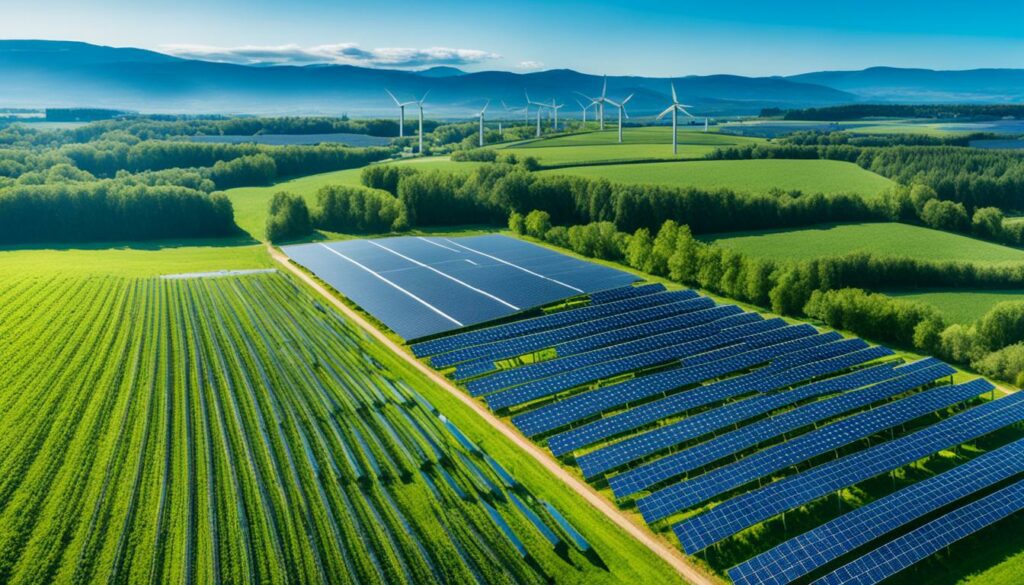
Agricultural grants cut costs for farmers. This lets them buy renewable tech. The help also includes money for research and training. This way, farmers learn about wind energy. They can make their farms more eco-friendly.
Rules that help with renewable energy are also important. The USDA’s Rural Development programme gives loans and grants. These are for better farms, businesses, and homes. They help millions in rural areas use clean energy. This makes communities stronger.
The USDA has spent over $1.8 billion since Biden and Harris started. This money goes to over 6,000 energy projects. The USDA is also putting $124 million into clean energy and fertiliser. This helps in 44 states. It shows the government’s support for a green future in farming.
| Programme | Funding | Objective |
|---|---|---|
| REAP | $144 million | Assist 400 farmers in deploying wind projects |
| DOE Grants | $4 million | Support distributed wind technologies and outreach |
| USDA Rural Development | $1.8 billion | Improvement of rural infrastructure and community facilities |
| Renewable Energy and Fertiliser Production | $124 million | Support projects in 44 states |
The USDA and DOE working together is really making a difference. They help farmers and their communities go green. This work is good for the environment and for local economies.
Climate change and more demand for food are big challenges today. But, new farming technologies are making big changes. Agrivoltaics and smart irrigation systems are leading this charge. They help farms be more sustainable and efficient all around the world.
Agrivoltaics are a mix of solar power and farming. They let crops grow under solar panels. This setup makes better use of the land and improves the crops’ yield. It also saves water. In Oregon, it made the area around solar arrays three times more water-efficient. So, these new ways of farming help grow crops and save water, which is very important.
Saving water is key in sustainable farming. Smart irrigation systems are a great answer. They use sensors and the internet to water crops just right. This saves money on water bills and helps the planet.
This tech also helps farming cope with a changing climate. It keeps farms productive even when water is scarce.
New energy and farming tech like agrivoltaics and smart systems keep getting better. They help farmers deal with changing weather, use less fossil fuel, and make farming more eco-friendly.
Farmers are leading the way in creating a sustainable future in farming. They champion practices that benefit both their local areas and the planet. Using renewable energy sources, they show key aspects of leading in the community and looking after nature.
Farmers who switch to renewable energy are like a guiding light. They share the economic and environmental perks with everyone around them. When they start projects like installing solar panels, they lower their own costs and set an example.
They teach and motivate other farmers to do the same, including how to get help from programs like the Rural Energy for America Program (REAP), which can fund 75% of renewable energy projects.
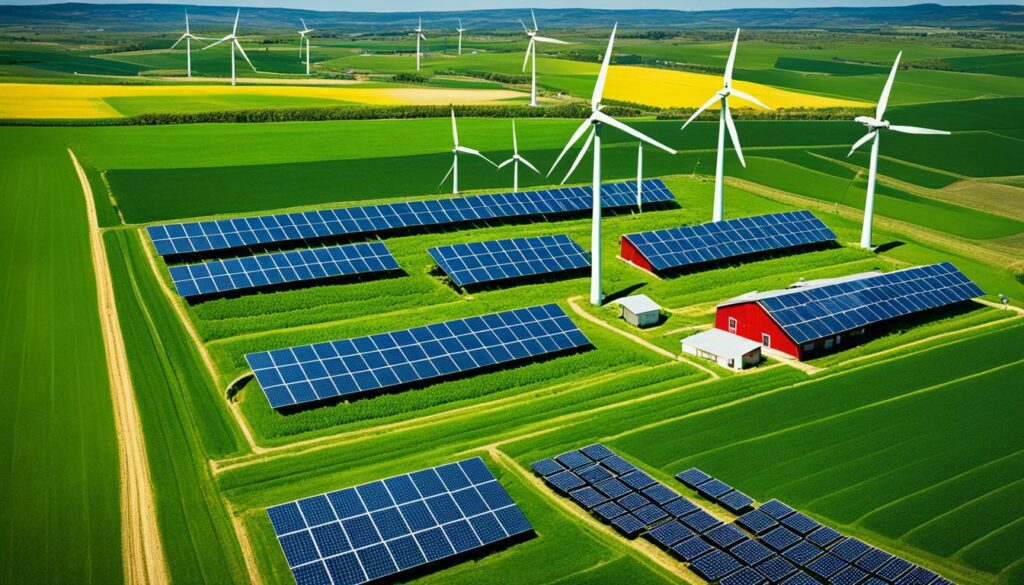
Farmers are more than food producers; they are protectors of the land. They use sources of energy that are kinder to the environment, like the wind and sun. This helps in reducing the use of fossil fuels and cutting down on harmful emissions.
For example, farmers like Roger Rainville in Vermont make their own biodiesel. This is cheaper than traditional fuel. Also, using wind turbines on their farms shows how they can use nature for energy in a sustainable way.
Community leadership and environmental stewardship are closely connected to a sustainable farming future. As farmers lead in using green energy, they pave the way for a lasting lifestyle. This ensures their communities thrive and leaves a cleaner planet for the coming generations.
Adoption of renewable energy in farming is changing the world. It shows a big move towards both environmental care and easier business in agriculture. Different parts of the world are applying renewable energy in their own ways. Europe, Asia, and North America stand out with their creative methods.
Farming in Europe is a leader in using renewable energy. The region aims high in fighting climate change. This leads to big spending on clean farming technology. Solar power is a big hit, cutting down power bills for many. Places with lots of wind use wind energy. They put up turbines that can also send power back into the main supply. These steps are making farming cheaper and more profitable.
Asia is not far behind, finding its own solutions for green farming. Farms, especially poultry ones, create biogas from animal waste. This is a step away from using up fossil fuels. It’s a smart move that shows Asia’s commitment to the planet.
In North America, farming is seeing various benefits from green energy. Take solar power in places like North Carolina. It provides a cheaper way to power farms than extending the usual power lines. Wind energy, where farmers earn money from having turbines on their land, is another example. This helps create a stable income for farmers.
| Region | Technologies Adopted | Benefits |
|---|---|---|
| Europe | Solar Power, Wind Energy | Reduced electricity bills, economic viability |
| Asia | Biogas | Reduced dependency on non-renewable resources |
| North America | Solar Power, Wind Energy | Lower costs, additional income streams |
The future of farming is changing fast. New technological advancements in agriculture and policies are making big differences. These changes are bringing many renewable energy innovations into the farm world. These help farming be more effective and green.
Farming is seeing a tech revolution. Solar power is a big hit, cutting electricity costs for farmers. Wind power is also on the rise. In windy areas, farms can make extra electricity to use or sell. And, biofuels are a green fuel option, cutting the need for harmful fossil fuels.
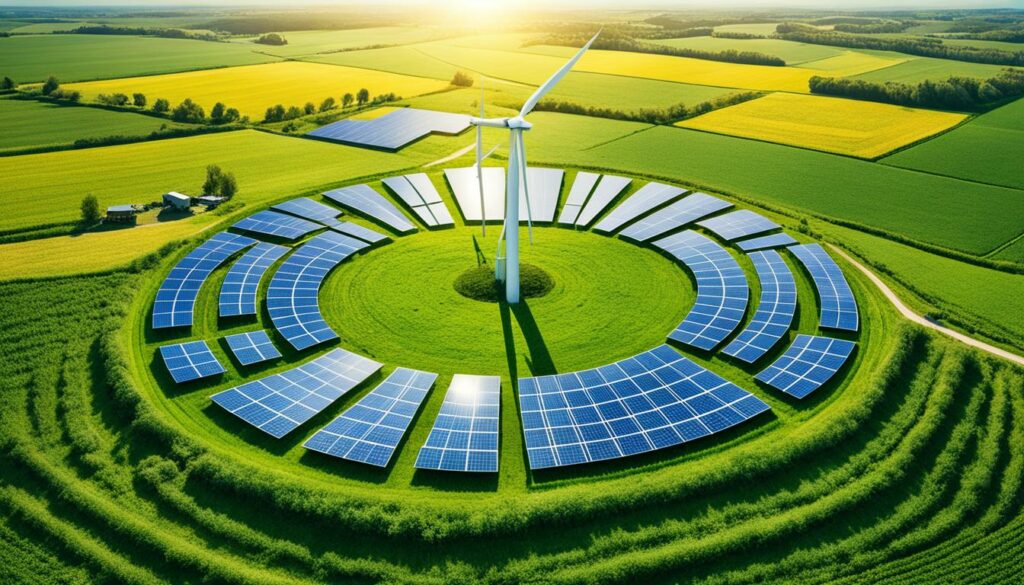
Choosing renewable energy means cheaper running costs for farms. For big farms, solar and wind systems can give lots of clean power. The REAP program helps pay for up to half the costs, sometimes even 75%, with grants and loans. This makes green energy even more attractive.
Energy policies are key to getting farms to go green. The Investment Tax Credit (ITC) can cut farmers’ solar system costs by 30%. States offer their own perks too, like grants and rebates. These help farms switch to power-saving strategies.
The EQIP On-Farm Energy Initiative is also giving farmers a hand. It helps after an energy audit to boost efficiency. With these policies, there’s lots of help and reward for farms going for greener, smarter operations.
| Technology | Benefits |
|---|---|
| Solar Power | Reduces electricity bills, ITC tax incentives |
| Wind Energy | Generates excess electricity, suitable for windy regions |
| Biofuels | Reduces dependence on fossil fuels, eco-friendly |
| REAP Grants | Covers 50%-75% of costs, boosts economic viability |
| State Programs | Financial incentives for energy-efficient projects |
Renewable energy is changing farming in big ways, showing great potential with its success stories and financial benefits. For example, a farmer in Vermont, Roger Rainville, can make biodiesel for less than $2 a gallon. In the Northeast, solar heating systems are being used in creative ways.
Farmers all over the United States are now using renewable energy sources like wind, solar, and more. This shift helps lower our need for fossil fuels that harm the environment. It also brings in good money. A New York farmer, Raymond Luhrman, is saving costs at his electric-powered farm. Using plants like camelina for biofuels is also helping farms make more money.
Looking ahead, we must support clean energy in farming. It needs teamwork between farmers, governments, and local people. Overcoming challenges like high start-up costs and knowing how to use new tech is crucial. But, with the right support, we can create a farming future that’s better for our planet. This will also help ensure there’s enough food for everyone, while fighting against climate change.
Integrating renewable energy in farming is key for several reasons. It boosts sustainability while meeting the world’s increasing food needs. It also helps fight climate change by cutting down on harmful gas emissions.
Solar, wind, geothermal energy, and biogas are commonly used in farming. They offer different benefits but all help make farming more sustainable and efficient.
Solar energy aids farming through agrivoltaic farming. This method means crops can grow under solar panels, using water 300% more efficiently. It also makes farming operations cheaper by reducing electricity bills.
Geothermal energy helps in many ways, including keeping greenhouses at the right temperature. This approach can save a lot of money, as shown by a flower farm cutting heating costs from
Integrating renewable energy in farming is key for several reasons. It boosts sustainability while meeting the world’s increasing food needs. It also helps fight climate change by cutting down on harmful gas emissions.
Solar, wind, geothermal energy, and biogas are commonly used in farming. They offer different benefits but all help make farming more sustainable and efficient.
Solar energy aids farming through agrivoltaic farming. This method means crops can grow under solar panels, using water 300% more efficiently. It also makes farming operations cheaper by reducing electricity bills.
Geothermal energy helps in many ways, including keeping greenhouses at the right temperature. This approach can save a lot of money, as shown by a flower farm cutting heating costs from $1,000 to $100 a month.
Farmers can earn more by leasing land for energy projects or selling extra energy. They also save money by using less expensive fossil fuels.
Some challenges involve the high upfront costs and fitting new technology into old systems. However, there are solutions like special financing, government help, and partnerships.
Renewable energy in farming cuts the need for fossil fuels and decreases harmful emissions. This is hugely important for worldwide efforts to reduce carbon and fight climate change.
Government policies are crucial. They provide grants, incentives, and rules that help farmers choose renewable energy. This allows for a shift to more environmentally friendly practices.
Agrivoltaics is one innovative method that mixes solar power with agriculture to boost land use and crop growth. Smart irrigation systems are another example, saving water and energy.
Farmers contribute to a sustainable future by adopting renewable energy and green practices. This not only leads by example but also encourages others to join in, benefiting both the environment and local economies.
The use of renewable energy in farming changes across the globe. Europe invests heavily in green farming tech due to strict climate goals. Asia focuses on biogas in poultry farming. North America sees many advantages from renewable energy, varying based on the project.
Future trends include more advanced solar and smart farm technologies. Governments will keep supporting green farming with policies and incentives, leading to more efficient and eco-friendly agricultural methods.
Farmers can earn more by leasing land for energy projects or selling extra energy. They also save money by using less expensive fossil fuels.
Some challenges involve the high upfront costs and fitting new technology into old systems. However, there are solutions like special financing, government help, and partnerships.
Renewable energy in farming cuts the need for fossil fuels and decreases harmful emissions. This is hugely important for worldwide efforts to reduce carbon and fight climate change.
Government policies are crucial. They provide grants, incentives, and rules that help farmers choose renewable energy. This allows for a shift to more environmentally friendly practices.
Agrivoltaics is one innovative method that mixes solar power with agriculture to boost land use and crop growth. Smart irrigation systems are another example, saving water and energy.
Farmers contribute to a sustainable future by adopting renewable energy and green practices. This not only leads by example but also encourages others to join in, benefiting both the environment and local economies.
The use of renewable energy in farming changes across the globe. Europe invests heavily in green farming tech due to strict climate goals. Asia focuses on biogas in poultry farming. North America sees many advantages from renewable energy, varying based on the project.
Future trends include more advanced solar and smart farm technologies. Governments will keep supporting green farming with policies and incentives, leading to more efficient and eco-friendly agricultural methods.